Meelup Regional Park facts for kids
Quick facts for kids Meelup Regional Park |
|
|---|---|

Meelup Beach
|
|
| Type | Regional Park |
| Location | Dunsborough, Western Australia |
| Area | 577 ha (1,430 acres) |
The Meelup Regional Park is a special coastal park found near the town of Dunsborough in Western Australia. It stretches for about 11.5 kilometers along the coast. This park connects Dunsborough to Bunker Bay, which is part of the Leeuwin-Naturaliste National Park.
Inside the park, you'll find amazing places like Meelup Beach and Eagle Bay. Other interesting spots include Gannett Rock, Rocky Point, Castle Bay, Curtis Bay, and Point Piquet. The park is a protected area, managed by the City of Busselton local government. They work together with the Meelup Regional Park Management Committee to look after it.
Contents
History of Meelup Park
Early People and Names
The first people to live in this area were the Noongar people, specifically the Wardandi group. They used to camp near a freshwater lagoon at Meelup Beach. They also fished for Australian salmon, which they called "Ngari." They still do this today.
The name "Meelup" has a few meanings. Some say it means "By the location of eyes" in the Wardandi language. Others believe it means "Place of the moon rising." This is because sometimes the full moon looks like it rises right out of the sea at Meelup Beach.
European Exploration and Early Uses
On May 30, 1801, a group from the Baudin expedition landed at Eagle Bay. They were looking for water but couldn't find any. Today, a special memorial remembers this event. It was put up in 2001.
In the 1800s, Castle Bay was used for whaling. The Castle Bay Whaling Company operated there from 1845 to 1872. Later, in the 1950s, people fished for salmon in Eagle Bay. Camping was also very popular at Meelup Beach until the 1970s.
How the Park Was Formed
In the 1980s, there were plans to build a fishing harbor at Point Picquet and a boat marina at Curtis Bay. Many people disagreed with these plans. This led to the creation of the Meelup Regional Park.
In 1993, the area officially became an "A-class reserve." This means it's a highly protected area. The City of Busselton manages the park in partnership with a special committee. The park was created by combining six existing protected areas. More land was added later to make the park even bigger.
Exploring Meelup Park's Features
The Meelup Regional Park has many exciting places to visit:
- Meelup Beach: This is the most popular spot in the park. It faces north-east, which makes it very unique.
- Gannett Rock
- Rocky Point
- Castle Bay
- Curtis Bay
- Point Piquet: This spot has a special platform where you can watch for whales.
- Eagle Bay: There are holiday houses nearby in the town of Eagle Bay.
The park also has several paths for walking and riding bicycles. In summer, the beaches are perfect for swimming. If you like surfing, you can find good waves in winter at Rocky Point, Point Piquet, and Castle Bay when the swells are strong. The dive wreck of HMAS Swan is also located nearby.
Plants and Animals of Meelup Park
Diverse Plant Life
The park is home to many different types of plants. You can find jarrah and marri forests. There are also banksia woodlands, areas with low shrubs, and many kinds of annual herbs and grasses. Beautiful orchids grow here too.
Two special plants are found only in this park. They are the Meelup mallee (Eucalyptus × phylacis) and the cape spider orchid (Caladenia caesarea subsp. maritima). These plants are called endemic, meaning they naturally grow nowhere else in the world.
Amazing Animals
Meelup Park is a safe home for many important animals. These include the southern brown bandicoot (also called Quenda), and several types of black cockatoos like the Carnaby's black cockatoo, Baudin's black cockatoo, and the red-tailed black cockatoo.
You might also spot the colorful rainbow bee-eater or the Caspian tern. Bats like the western false pipistrelle and the western ringtail possum also live here.
Protecting the Park
Sometimes, animals like cats, rabbits, and foxes that don't belong in the park cause problems. Certain plants, such as the bridal creeper, arum lily, one-leaf Cape tulip, and Sydney Golden Wattle, can also harm the native plants. There's also a plant disease called dieback, caused by Phytophthora cinnamomi, which can damage trees. People work hard to protect the park from these issues.

